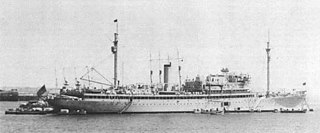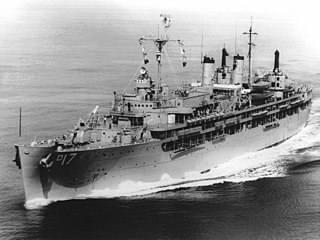
USS Arnold J. Isbell (DD-869), a Gearing-class destroyer, was the only ship of the United States Navy to be named for Arnold J. Isbell, an aircraft carrier captain during World War II. The ship was laid down on 14 March 1945 at Staten Island, New York, by Bethlehem Mariners Harbor, launched on 6 August 1945 and commissioned on 5 January 1946. Constructed too late to see action in World War II, the vessel initially served as a training ship with the United States Atlantic Fleet, before transferring to the Pacific and deploying to Korea during the Korean War and off the Vietnam coast during the Vietnam War. In 1972 Arnold J. Isbell was made part of the reserve training fleet and in 1974, sold to Greece where the ship was renamed Satchouris and served with the Hellenic Navy until being sold for scrap in 2002.

USS Richard S. Edwards (DD-950), named for Admiral Richard Stanislaus Edwards USN (1885–1956), was a Forrest Sherman-class destroyer built by the Puget Sound Bridge and Dredging Company at Seattle, Washington and launched on 24 September 1957 by Mrs. W. B. Franke; and commissioned 5 February 1959.

USS Turner Joy (DD-951) is one of 18 Forrest Sherman-class destroyers of the United States Navy. She was named for Admiral Charles Turner Joy USN (1895–1956). Commissioned in 1959, she spent her entire career in the Pacific. She participated extensively in the Vietnam War, and was one of the principal ships involved in the Gulf of Tonkin incident.

USS Duncan (DD-874) was a Gearing-class destroyer of the United States Navy, the third named for Captain Silas Duncan USN (1788–1834). The ship was laid down by the Consolidated Steel Corporation at Orange, Texas on 22 May 1944, launched on 27 October 1944 by Mrs. D. C. Thayer and commissioned on 25 February 1945. The ship was sunk in 1980.

USS Bryce Canyon (AD-36) was a Shenandoah-class destroyer tender, the only ship to be named for the Bryce Canyon National Park in Utah.

The second USS Dixie (AD-14) was the first of her class of destroyer tenders built just before the start of World War II for the U.S. Navy. Her task was to service destroyers in, or near, battle areas and to keep them fit for duty.

USS O'Brien (DD-725), an Allen M. Sumner-class destroyer, was the fourth ship of the United States Navy to be named after Captain Jeremiah O'Brien and his five brothers, Gideon, John, William, Dennis and Joseph, who captured HMS Margaretta on 12 June 1775 during the American Revolution.

USS Alfred A. Cunningham (DD-752), an Allen M. Sumner-class destroyer, is the only ship of the United States Navy to be named for Alfred Austell Cunningham, a USMC officer and aviator.

USS Samuel Gompers (AD-37) was a destroyer tender, the first of her class, and designed to be a floating repair shop for ships of the U.S. Navy either in port or at sea. The vessel was named for Samuel Gompers, a distinguished American labor leader during the late nineteenth century.

USS Frontier (AD-25) was one of four Klondike class destroyer tenders built at the tail end of World War II for the United States Navy.

USS Whitney (AD-4) was a Dobbin-class destroyer tender named for United States Secretary of the Navy William Collins Whitney. She was launched on 12 October 1923, and was commissioned on 2 September 1924.

USS Henderson (DD-785) was a Gearing-class destroyer of the United States Navy, the second Navy ship of that name, and the first named for United States Marine Corps Major Lofton R. Henderson. The previous Henderson was named for Marine Corps Commandant Archibald Henderson.

USS Klondike (AD-22/AR-22) was a destroyer tender in service the United States Navy from 1945 to 1970. In 1960, she was redesignated as a repair ship. After spending another five years in reserve, she was sold for scrap in 1975.

USS Altair (AD-11) was the lead ship of a class of three United States Navy destroyer tenders. She was named for Altair, the brightest star in the constellation Aquila, and was in commission from 1921 to 1946, seeing service during World War II.

USS Piedmont (AD–17) was a Dixie-class destroyer tender built during World War II for the United States Navy. Her task was to service destroyers in, or near, battle areas and to keep them fit for duty. She served in the Pacific Ocean during World War II, the Cold War, the Korean War, and the Vietnam War. For her work in battle areas, the ship was awarded four battle stars for her Korean War efforts and one for Vietnam War service.

USS Hamul (AD-20) was the lead ship of a class of two destroyer tenders; she was most likely named after Hamal, the brightest star in the constellation Aries.
USS Markab (AD-21) was a Hamul-class destroyer tender named for Markab, the third-brightest star in the constellation Pegasus.

USS Black Hawk (AD-9) was a destroyer tender.
USS Incredible (AM-249) was an Admirable-class minesweeper built for the U.S. Navy during World War II. She was built to clear minefields in offshore waters, and served the Navy in the North Atlantic Ocean and then in the Pacific Ocean. She returned home, finishing the war with two battle stars to her credit. When she was recalled for duty in the Korean War, she returned home again with four more battle stars.

USS Navasota (AO-106) was an Ashtabula-class replenishment oiler that served in the U.S. Navy from 1946 to 1973, then transferred to the Military Sealift Command to continue service as United States Naval Ship USNS Navasota (T-AO-106) until taken out of service in 1992. Navasota was sold for scrapping in 1995. She was the only U.S. Navy ship to bear the name Navasota.



















